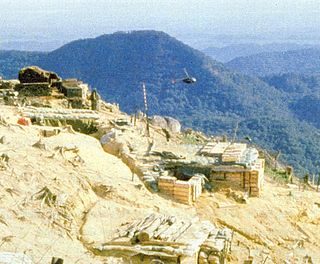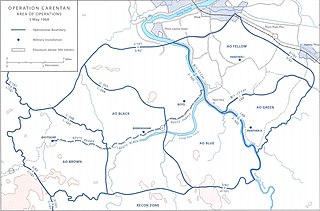Operation Jefferson Glenn ran from 5 September 1970 to 8 October 1971 and was the last major operation in which U.S. ground forces participated during the Vietnam War and the final major offensive in which the 101st Airborne Division fought. This was a joint military operation combining forces of the 101st Airborne and the Army of the Republic of Vietnam (ARVN) 1st Infantry Division.

Operation Lam Son 719 or 9th Route – Southern Laos Campaign was a limited-objective offensive campaign conducted in the southeastern portion of the Kingdom of Laos. The campaign was carried out by the armed forces of South Vietnam between 8 February and 25 March 1971, during the Vietnam War. The United States provided logistical, aerial and artillery support for the operation, but its ground forces were prohibited by law from entering Laotian territory. The objective of the campaign was the disruption of a possible future offensive by the People's Army of Vietnam (PAVN), whose logistical system within Laos was known as the Ho Chi Minh Trail.

The Battle of Fire Support Base Ripcord was a 23-day battle between elements of the U.S. Army 101st Airborne Division and two reinforced divisions of the People's Army of Vietnam (PAVN) that took place from 1 to 23 July 1970. It was the last major confrontation between United States ground forces and the PAVN during the Vietnam War. Three Medals of Honor and six Distinguished Service Crosses were awarded to participants for actions during the operations.
The Battle of A Shau was waged in early 1966 during the Vietnam War between the People's Army of Vietnam (PAVN) and the forces of the United States and South Vietnam. The battle began on March 9 and lasted until March 10 with the fall of the U.S. Army's Special Forces camp of the same name. The battle was a strategic victory for the PAVN in that they were able to take control of the A Shau Valley and use it as a base area for the rest of the war.
The Battle of FSB Mary Ann occurred when Viet Cong (VC) sappers attacked a U.S. firebase located in Quảng Tín Province, South Vietnam early on the morning of 28 March 1971.
The lead-up to the Battle of Kontum began in mid-1971, when North Vietnam decided that its victory in Operation Lam Son 719 indicated that the time had come for large-scale conventional offensives that could end the war quickly. The resulting offensive, planned for the spring of 1972, would be known as the Easter Offensive in the South and the Nguyen Hue Offensive in the North, Nguyen Hue being a hero of Vietnamese resistance against the Chinese in 1789. The Easter Offensive would make use of fourteen divisions and would be the largest in the war.

William Edward Adams was a major in the United States Army who was posthumously awarded the Medal of Honor for his actions during the Vietnam War.

Operation Carentan and Operation Carentan II were security operations conducted during the Vietnam War by the U.S. 1st and 2nd Brigades, 101st Airborne Division and the 3rd Brigade, 82nd Airborne Division in Thừa Thiên Province, South Vietnam from 18 March to 17 May 1968.
Operation Texas Star was a military operation of the Vietnam War that took place in Quảng Trị and Thừa Thiên Provinces from 1 April to 5 September 1970.
Operation Kentucky Jumper was a joint U.S. Army and Army of the Republic of Vietnam (ARVN) military operation during the Vietnam War designed to seek out and destroy People's Army of Vietnam (PAVN) and Vietcong (VC) units, interdict their base areas and infiltration routes and to support the Accelerated Pacification Program southwest of Huế, Thừa Thiên Province.
Firebase Illingworth is a former U.S. Army firebase northwest of Tây Ninh in southwest Vietnam.

Firebase Bird was a U.S. Army firebase located in the Kim Son Valley in southern Vietnam during the Vietnam War.
Operation Nevada Eagle was a security operation during the Vietnam War in Thừa Thiên Province, that took place from 17 May 1968 to 28 February 1969.
Operation Clinch Valley was a joint U.S. Army and Army of the Republic of Vietnam (ARVN) military operation during the Vietnam War to engage People's Army of Vietnam (PAVN) units on the Khe Sanh plateau and prevent them from reinforcing PAVN units in the A Sầu Valley.
Operation Randolph Glen was a joint U.S. Army and Army of the Republic of Vietnam (ARVN) military operation during the Vietnam War designed to keep pressure on the People's Army of Vietnam (PAVN) units in Thừa Thiên Province and prevent them from mounting any attacks on the populated coastal regions.
Firebase O'Reilly is a former Army of the Republic of Vietnam (ARVN) firebase located south of Quảng Trị in Quảng Trị Province, Vietnam.
Operation Toan Thang III was a U.S. Army and Army of the Republic of Vietnam (ARVN) operation conducted between 17 February and 31 October 1969 in the Vietnam War. The operation was designed to keep pressure on Vietcong (VC) and People's Army of Vietnam (PAVN) forces in III Corps.
Operation MacArthur was a United States Army military operation in the Central Highlands of South Vietnam from 12 October 1967 to 31 January 1969. The early phases of the operation encompassed the Battle of Dak To from 3 to 23 November 1967.
The DMZ Campaign (1969–71) was a military campaign by the United States Army, United States Marine Corps (USMC) and the Army of the Republic of Vietnam (ARVN) against the People’s Army of Vietnam (PAVN) along the Vietnamese Demilitarized Zone (DMZ) in northern Quảng Trị Province from 1969 to 1971 during the Vietnam War.

Dennis Marc Fujii is a retired United States Army soldier who received the Medal of Honor in 2022 for his actions in the Vietnam War in 1971.










